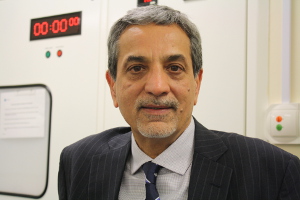Herniae of the abdominal wall represent common surgical complaints which are often troublesome and interfere with a patient’s work and daily routine. The most up-to-date minimally invasive techniques are utilised to ensure that patients with herniae are offered effective treatment with the aim of optimising their post operative recovery.
What is a hernia?
A hernia is a protrusion of tissue or an organ through a defect so that it lies in an abnormal region. The commonest herniae are those of the abdominal cavity and are usually characterised by feeling a lump.
The underlying problem which leads to an abdominal wall hernia is a defect or weakness in abdominal wall muscles so that the organs and tissues behind are able to push forwards. This gives rise to a lump which may be more obvious when straining (i.e. coughing, standing or during lifting) and less obvious (or even disappears) when lying down.
What type of hernia do I have?
The name given to a hernia is dependent upon where the site of the weakness in the muscles of the abdominal wall, this in turn will determine where the lump associated with the hernia is felt. The commonest hernia is an inguinal in hernia where a lump is felt in the groin.
What symptoms am I likely to get from a hernia?
In most cases a hernia is associated with an intermittent lump. This is most obvious at times of straining and may disappear or be less obvious when sitting or lying down. The hernia may be associated with a feeling of discomfort (usually described as a dragging sensation) which is again worst at times of straining.
The most worrying complication occurs if a segment of the bowel manages to get into the hernia and gets stuck. This is known as an obstructed hernia and may be associated with an enlargement of the hernia, failure of the hernia to disappear when lying down and severe abdominal pain. If an obstructed hernia is not reduced the segment of bowel within it may become damaged and its blood supply compromised – this is known as a strangulated hernia. The latter two complications are uncommon but represent surgical emergencies.
What factors should I consider before deciding on treatment?
Once a hernia has formed it will not go away without surgical correction. However here are some common considerations to take into account before deciding on firstly whether an operation should be performed and secondly which operation is best for you.
- Does the hernia cause pain or discomfort?
Obviously the more a hernia troubles you the more likely that you will want to consider an operation. In particularly, if a hernia is causing constant pain it is important that you are seen urgently as this may be an indicator of obstruction or potential strangulation.
- Is the hernia interfering with my lifestyle?
As above the more that a hernia is troubling you the more likely that you are to consider an operation. If a hernia is preventing you working or interfering with your ability to enjoy sport and leasure activities it is likely that you will be more inclined towards considering an operation.
- Is there a risk of strangulation or other complications?
Certain hernias are more liable to obstruct and strangulate than others. As above those that are painful are likely to be at highest risk, in addition hernias through a narrow muscle defect are at risk.
What are the risks of an operation?
The risks of any operation must be assessed on an individual basis – taking into account your previous health. There are specific risks associated with each different type of hernia but these are generally uncommon. The general risks associated with hernia surgery are of infection ( less than 2 in 100), bruising around the operation site and recurrence of the hernia (dependant upon the hernia site).
Should I have an open or laparoscopic (“Keyhole”) hernia repair?
This may not be relevant to every situation but certainly applies to the most common herniae. In a laparoscopic procedure a laparoscope, which is a small telescope like devise adapted for looking into the abdominal cavity, is used to visualise the hernia from behind the muscle. The hernia is repaired by positioning a mesh overlying the weakened area. This technique has the advantage of needing a smaller scar than the open procedure and as a result is less painful. There is little doubt that laparoscopic hernia repairs do result in earlier return to full activities than an open operation and recent evidence suggests are associated with fewer complications.
Laparoscopic surgery does require a general anaesthetic and this may not be possible in some patients. In addition some herniae may not be suitable for laparoscopic surgery. In an open hernia repair a cut is made over the site of the hernia and the weakened muscle identified. The weakness is usually repaired by placing a mesh over the relevant area but if the hernia is very small it may be more appropriate to suture it.
Following repair of my hernia is it at risk of coming back?
There is a risk of recurrence. The risk is however is small with use of modern techniques and newer mesh materials.
In addition to recurrence of a hernia patients who have developed one hernia are at slightly greater risk of developing hernia at other sites.


